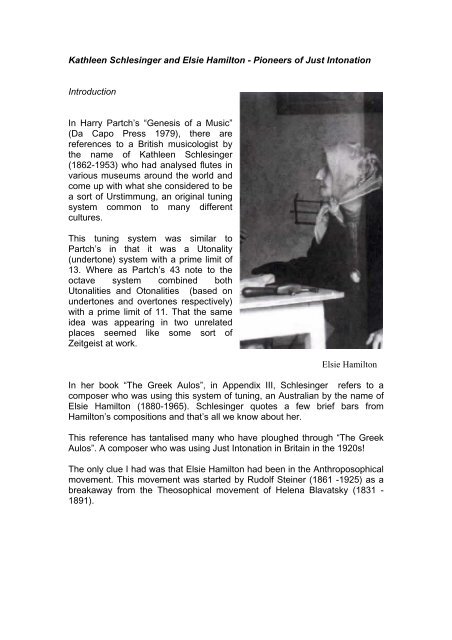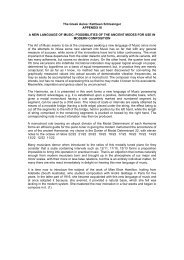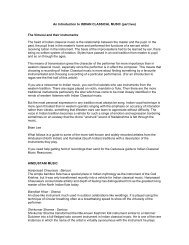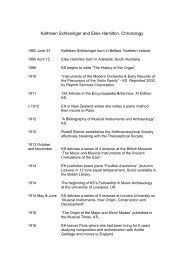Kathleen Schlesinger and Elsie Hamilton - Pioneers of ... - Naked Light
Kathleen Schlesinger and Elsie Hamilton - Pioneers of ... - Naked Light
Kathleen Schlesinger and Elsie Hamilton - Pioneers of ... - Naked Light
Create successful ePaper yourself
Turn your PDF publications into a flip-book with our unique Google optimized e-Paper software.
<strong>Kathleen</strong> <strong>Schlesinger</strong> <strong>and</strong> <strong>Elsie</strong> <strong>Hamilton</strong> - <strong>Pioneers</strong> <strong>of</strong> Just IntonationIntroductionIn Harry Partch’s “Genesis <strong>of</strong> a Music”(Da Capo Press 1979), there arereferences to a British musicologist bythe name <strong>of</strong> <strong>Kathleen</strong> <strong>Schlesinger</strong>(1862-1953) who had analysed flutes invarious museums around the world <strong>and</strong>come up with what she considered to bea sort <strong>of</strong> Urstimmung, an original tuningsystem common to many differentcultures.This tuning system was similar toPartch’s in that it was a Utonality(undertone) system with a prime limit <strong>of</strong>13. Where as Partch’s 43 note to theoctave system combined bothUtonalities <strong>and</strong> Otonalities (based onundertones <strong>and</strong> overtones respectively)with a prime limit <strong>of</strong> 11. That the sameidea was appearing in two unrelatedplaces seemed like some sort <strong>of</strong>Zeitgeist at work.<strong>Elsie</strong> <strong>Hamilton</strong>In her book “The Greek Aulos”, in Appendix III, <strong>Schlesinger</strong> refers to acomposer who was using this system <strong>of</strong> tuning, an Australian by the name <strong>of</strong><strong>Elsie</strong> <strong>Hamilton</strong> (1880-1965). <strong>Schlesinger</strong> quotes a few brief bars from<strong>Hamilton</strong>’s compositions <strong>and</strong> that’s all we know about her.This reference has tantalised many who have ploughed through “The GreekAulos”. A composer who was using Just Intonation in Britain in the 1920s!The only clue I had was that <strong>Elsie</strong> <strong>Hamilton</strong> had been in the Anthroposophicalmovement. This movement was started by Rudolf Steiner (1861 -1925) as abreakaway from the Theosophical movement <strong>of</strong> Helena Blavatsky (1831 -1891).
Historical <strong>and</strong> Metaphysical contextBlavatsky is a controversial figure. Her philosophy took many elements fromthe Indian traditions, notably Vedanta (the philosophy <strong>of</strong> the Upanishads) <strong>and</strong>integrated them into a wider system that saw all religious paths leadingultimately to the same end. She also took on board the historical perspective<strong>of</strong> Vedanta, namely the concept <strong>of</strong> ages. In Indian philosophy these areimmense timespans <strong>of</strong> man’s evolution representing only moments in a day <strong>of</strong>the creator god Brahma. Into this timescale Blavatsky, in her syncreticmanner, weaves other narratives including the legendary civilisations <strong>of</strong>Atlantis <strong>and</strong> Lemuria <strong>and</strong> material she gleaned from channelled entities <strong>and</strong>psychic investigation.Theosophy has been part <strong>of</strong> the world view <strong>of</strong> many internationally renownedartists such as the painters K<strong>and</strong>insky <strong>and</strong> Roerich, the composers Scriabin<strong>and</strong> Dane Rudhyar.Steiner broke with Theosophy when Blavatsky’s heir, Annie Besant declaredKrishnamurti to be the second coming <strong>of</strong> Christ (a claim which Krishnamurtilater repudiated).Steiner’s philosophy, known as Anthroposophy, although mystical, was morerooted in Christianity <strong>and</strong> the scientific theories <strong>of</strong> Goethe. What it kepthowever, among other things, was the Theosophical concept <strong>of</strong> time <strong>and</strong> theidea that we are living in the post-Atlantean age (the time since the legendarycontinent <strong>of</strong> Atlantis sank beneath the waves). Steiner further developed ideas<strong>of</strong> the relationship between these ages <strong>and</strong> the evolution <strong>of</strong> humanconsciousness.This is the philosophical background to the thinking <strong>of</strong> both <strong>Schlesinger</strong> <strong>and</strong><strong>Hamilton</strong>. From reading <strong>Schlesinger</strong>’s work, my impression is that her searchwas for this Urstimmung. This she thought she had found in themeasurements <strong>of</strong> flutes from various cultures. The analysis <strong>of</strong> thesemeasurements led her to construct her system <strong>of</strong> Harmoniai. This system shethen overlaid with philosophical <strong>and</strong> mystical concepts from Anthroposophysuch as the association <strong>of</strong> each mode with a particular planetary energy in theastrological sense.Inevitably her theories came under criticism from other academics. EvenDane Rudhyar, no mean mystic himself, asserts that <strong>Schlesinger</strong> “totallymisunderstood the early development <strong>of</strong> music.” (The Magic <strong>of</strong> Tone <strong>and</strong> theArt <strong>of</strong> Music. Dane Rudhyar. Shambhalla Publications. Boulder CO. 1982)According to American musicologist, John Chalmers “Although <strong>Schlesinger</strong>'stheories are considered incorrect by most scholars <strong>of</strong> classical Greek music,her scales form a fascinating musical system in their own right.”
For me, however, as a composer working with non-st<strong>and</strong>ard tuning systems, Ifind <strong>Schlesinger</strong>’s system the most satisfying <strong>and</strong> useful. There is an internalconsistency <strong>and</strong> mathematical rigour <strong>and</strong> elegance that I like. In addition, it iseasy to explain to musicians <strong>and</strong> non-musicians alike.In my own research I have exp<strong>and</strong>ed the idea <strong>of</strong> Modal Determinants (MDs)to higher numbers so that lower MDs become subsets <strong>of</strong> those higher. I havehowever stayed within the prime limit <strong>of</strong> 13 used by KS <strong>and</strong> EH because Icannot feel the quality <strong>of</strong> higher prime numbers such as 17 or 19. I don’t gettheir sense <strong>of</strong> identity.What counts in musicThis raises a major point <strong>and</strong> links us back to Steiner’s work on Goethe’sscientific theories. For Goethe <strong>and</strong> for Steiner, western science has made themistake <strong>of</strong> concentrating solely on quantitative aspects (that which can bemeasured) <strong>and</strong> ignoring quality.Albert Einstein had a sign hanging in his <strong>of</strong>fice at Princeton that read: “Noteverything that counts can be counted, <strong>and</strong> not everything that can becounted counts.”But number is more than just a system <strong>of</strong> counting things. To a Jungiananalyst, numbers are archetypes with symbolic associations. To thesynaesthete, numbers are identities with their own individual qualities: tastes,textures, smells <strong>and</strong> personalities. But synaesthesia is in fact a continuum;something we all partake <strong>of</strong> to a greater or less extent. The ability to perceivethe emotive, textural, sensory etc quality <strong>of</strong> number is not restricted to an oddfew.Through working with tunings, many people have come to this sense <strong>of</strong>vibrations as identities. Partch talks <strong>of</strong> odentities <strong>and</strong> udentities. AlainDaniélou (Music <strong>and</strong> the Power <strong>of</strong> Sound: The Influence <strong>of</strong> Tuning <strong>and</strong>Interval on Consciousness. Inner Traditions International 1965) talks <strong>of</strong> themetaphysical qualities <strong>and</strong> effect on consciousness <strong>of</strong> different primenumbers.This right-brained way <strong>of</strong> appreciating number is fundamental to the way <strong>of</strong>working with tunings <strong>and</strong> is the complete antithesis <strong>of</strong> Schoenberg’s twelvetone system. As Lou Harrison puts it in in his Music Primer <strong>of</strong> 1970, “Thus, he[Schoenberg] substituted an order <strong>of</strong> succession for a hierarchy <strong>of</strong>relationships.”It is the Cartesian paradigm <strong>of</strong> the split between the observer <strong>and</strong> theobserved (based on the thinking <strong>of</strong> Aristotle) that has taken us out <strong>of</strong>relationship to nature. Nature has become a thing out there, an “it”, somethingwe are not a part <strong>of</strong>. This dualistic thinking has led to our delusion <strong>of</strong>
dominance over nature <strong>and</strong> is at the basis <strong>of</strong> the ecological crisis we findourselves in. It is no coincidence that Descartes <strong>and</strong> the so-called “Age <strong>of</strong>Enlightenment” was contemporary with the introduction <strong>of</strong> EqualTemperament where the harmonic relationship between notes is severed.(Twelve tone equal temperament which predominates in the west, is based onan irrational number, the twelfth root <strong>of</strong> two - the number which has to bemultiplied by itself 12 times to make 2 - or approximately 1.0594630943593.)In the non-dualistic paradigm, the observer is not separate from what isobserved. This paradigm is fundamental to subatomic physics sinceHeisenberg <strong>and</strong> Schrödinger. At the human scale, it means looking at natureas a “you” rather than an “it”, the word “you” implying relationship.In Just Intonation, the notes relate to each other in simple whole-numberratios. Relationship is built in to the fabric <strong>of</strong> the tuning. It only has to berevealed in the course <strong>of</strong> a piece <strong>of</strong> music. And as there is harmonicrelationship between the notes, there is an intrinsic relationship between themusic <strong>and</strong> the audience.* * *Reading the written works <strong>of</strong> <strong>Schlesinger</strong> <strong>and</strong> <strong>Hamilton</strong> elsewhere on this site:The Nature <strong>of</strong> Musical Experience in the <strong>Light</strong> <strong>of</strong> Anthroposophy by <strong>Elsie</strong><strong>Hamilton</strong>The Modes <strong>of</strong> Ancient Greece by <strong>Elsie</strong> <strong>Hamilton</strong>The Language <strong>of</strong> Music by <strong>Kathleen</strong> <strong>Schlesinger</strong>The Return <strong>of</strong> the Planetary Modes by <strong>Kathleen</strong> <strong>Schlesinger</strong>will give deeper insights in to the world view <strong>of</strong> these two pioneers <strong>of</strong>alternative tuning.<strong>Schlesinger</strong>’s magnum opus “The Greek Aulos” (Methuen. London. 1939)is out <strong>of</strong> print but a copy is available on inter-library loan from the BritishLibrary in Boston Spa to readers in the UK.On this site as well are reproductions <strong>of</strong> scores in pdf format some kindlyphotocopied by John Wood <strong>of</strong> Stroud others made available by the library inDornach, Switzerl<strong>and</strong>.* * *Of <strong>Elsie</strong> <strong>Hamilton</strong> we know very little. She was born in 1880 in Adelaide,South Australia where she knew Hooper Brewster-Jones, a pioneeringAustralian modernist. Came to Britain in 1906. Was a concert pianist <strong>and</strong>composer in equal temperament (her only extant composition in EqualTemperament is Feuilles D’Automne for piano) before meeting <strong>Schlesinger</strong><strong>and</strong> deciding to devote her life to composing using <strong>Schlesinger</strong>’s Harmoniai.Her key written work is “The Modes <strong>of</strong> Ancient Greece”, a booklet where shedescribes 7 scales relating to the seven planets known to the ancients.
She travelled around Europe (Germany, the Netherl<strong>and</strong>s, Finl<strong>and</strong>)demonstrating <strong>and</strong> talking about the tuning system <strong>and</strong> her compositons.Later she took on a position as music teacher at a Steiner school in Stroud,Gloucestershire, UK. After which she returned to Australia.<strong>Elsie</strong> <strong>Hamilton</strong> (right) conducting an ensemble <strong>of</strong> lyres, cello <strong>and</strong> fluteSome <strong>of</strong> the scores presented here were donated by John <strong>and</strong> Daisy Woodwho taught with <strong>Hamilton</strong> at the school. Also the copy <strong>of</strong> her summary <strong>of</strong><strong>Schlesinger</strong>’s tuning system “The Modes <strong>of</strong> Ancient Greece” which is e-published here for the first time in pdf format. The articles: The Nature <strong>of</strong>Musical Experience in the <strong>Light</strong> <strong>of</strong> Anthroposophy by <strong>Elsie</strong> <strong>Hamilton</strong>, TheLanguage <strong>of</strong> Music by <strong>Kathleen</strong> <strong>Schlesinger</strong>, <strong>and</strong> The Return <strong>of</strong> the PlanetaryModes by <strong>Kathleen</strong> <strong>Schlesinger</strong> were found in the Library <strong>of</strong> Steiner House,Park Street, London, UK.It is believed that <strong>Elsie</strong> <strong>Hamilton</strong> returned to Australia after retiring fromteaching <strong>and</strong> died in 1965. Despite attempts to contact Anthroposophicalinstitutions in Australia, we have no further knowledge <strong>of</strong> her or her heirs. Thetexts <strong>and</strong> scores available here are presented free <strong>of</strong> charge as the copyright<strong>of</strong> them is unknown. They are presented with an intent with which I believe<strong>Elsie</strong> <strong>Hamilton</strong> would have concurred: to harmonise humanity with the cosmosthrough music. May her work continue.Brian Lee, London UK, 2006http://www.nakedlight.co.ukinfo@nakedlight.co.uk
<strong>Elsie</strong> <strong>Hamilton</strong> (with her back to us)conducting an ensembleThanks are due to John <strong>and</strong>Daisy Wood, JamesD’Angelo, Michael DeasonBarrow, John Chalmers,Warren Burt <strong>and</strong> theAnthroposophical library <strong>of</strong>Dornach for help with theresearch into <strong>and</strong>preparation <strong>of</strong> this material.





